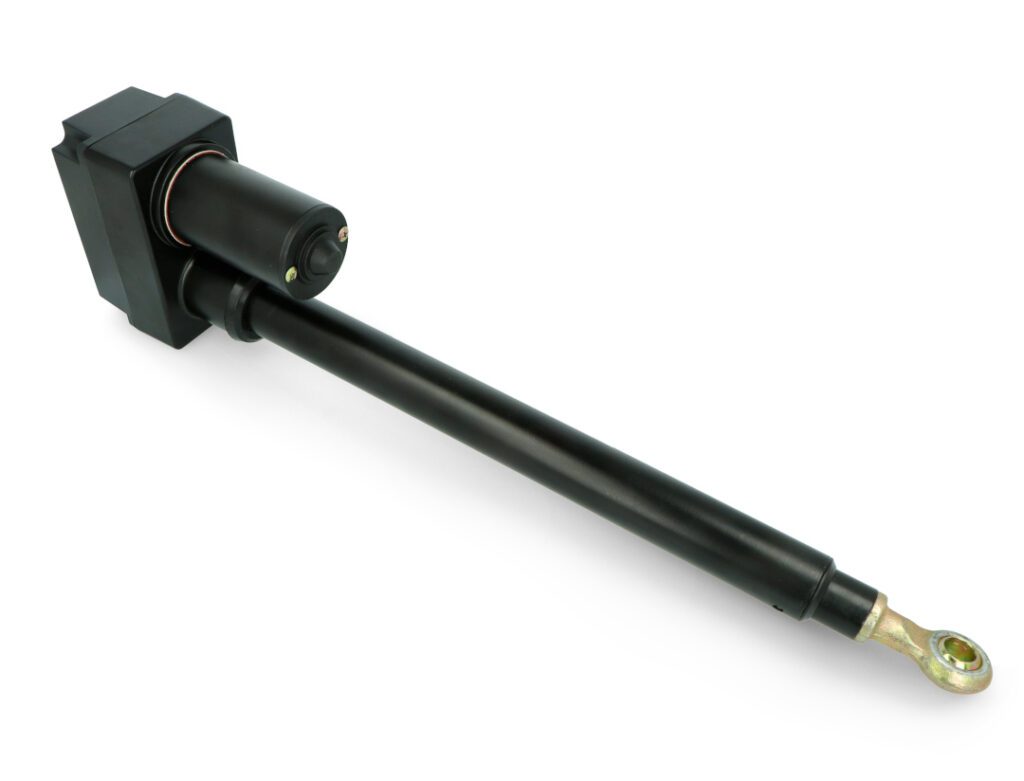Table of Contents:
Converting rotary motion into a pushing or pulling linear motion can be used for lifting, lowering, moving or tilting.
From the article, you will learn what a linear actuator is, the types of linear actuators, how a linear actuator works and its design.
Linear actuator - what is it?
Electric linear actuators use a DC or AC motor with a series of gears and a traction screw to push the main shaft of the rod.
The difference between actuators depends on the size of the motor, which can range from 12 V DC to 48 V DC.
Important terms are static load capacity and dynamic load capacity – these are variables for the load capacity of linear actuators.
Dynamic lifting capacity is the amount of force applied when the actuator is in motion. Static lifting capacity occurs when the actuator is stationary and holds the load in place.
These properties make linear actuators an increasingly popular solution, and they have long opened automatic doors for us, moved car seats forward and backward, and opened and closed computer disk drives.
The basic principle of linear actuators is the concept of an inclined plane, in which the actuator’s traction screw moves along a ramp with a small rotational force.
Types of linear actuators
We started with electric, and the simplest form of actuator, which converts rotary motion into linear motion, are mechanical actuators.
Actuators with a ball screw, a setscrew, a pinion, a belt and a cam are classified as mechanical.
Hydraulic cylinders are hydraulic cylinders with a piston that use incompressible fluid to create an unbalanced pressure on the piston to achieve linear displacement.
For example, pressurized fluid enters through a port on the left side of the chamber and presses against the surface of the piston.
When the fluid pressure is released, the piston moves back to the left.
Pneumatic actuators quickly produce low to medium force and are used as servos.
Pneumatic linear actuators use compressed air to convert energy into mechanical motion.
They consist of a piston, cylinder and valve or port that can produce linear or rotary mechanical motion.
Slightly less commonly associated piezoelectric actuators use the piezoelectric effect, which is electrical energy generated by pressure and latent heat, resulting in an electromechanical interaction between mechanical and electrical states.
Piezoelectric actuators have multiple layers of piezoelectric elements such as ceramics, which combine the effect of each element’s expansion to produce motion.
Quite unusual retractable actuators have magnets, which generate a magnetic field that produces a current to move a coil to produce a shaft or pendulum motion.
The force of the movement is proportional to the number of coils of the coil and the magnetic flux and current.
Increasing the current increases the force.
It is worth mentioning electromechanical actuators, which are programmable, and the profile of movement and force depends more on us.
Although an electromechanical actuator is quite similar to mechanical actuators, they are obviously different in their use of drives such as brushless DC motors, stepper or servo.
The rest are mostly simplified, standard and compact designs.
How does a linear actuator work?
The linear actuator moves in a … straight line.
Although the basic function of the actuator is the same, there are different ways to achieve the movement.
Applications for linear actuators include wheelchair ramps, toys and technological instruments for spacecraft.
The operation of the actuator itself, on the other hand, is quite simple.
A screw, such as a traction screw, ball screw or roller screw, is used depending on the required performance and produces motion.
It accomplishes this by rotating clockwise or counterclockwise, which causes the nut on the screw to move to produce linear motion.
Ball screws are ideal for fast and dynamic applications that require precise positioning, while rollers are best for high forces.
Motion of the linear actuator
Typical motor has a voltage range from 12 V DC to 48 V DC. Brush DC actuators have a switch to reverse the polarity of the motor, which changes the motion. Servo i stepper motors require control electronics, and Hall-effect (Hall sensors) i encoders.
The actuator’s control electronics can be externally available or built-in. The speed and force of the actuator depends on its gearing – naturally, a gearing that reduces the speed of the actuator provides more force, since there is a correlation between speed and force.
One of the main differences between actuators in terms of motion is their stroke, which is defined by the length of the screw and shaft.
The speed depends on the gears that connect the motor to the screw.
The mechanism for stopping the stroke of an actuator includes limit switches or small switches, encoders or linear potentiometers.
Construction of the linear actuator
Motor AC or DC provides the energy needed to drive the actuator.
Although electricity is the most common source of energy, air and fluid energy are also used – the differences are understandable after reading the paragraph on actuator types.
A power converter delivers power from the source to the actuator using measurements from the controller.
Examples of industrial power converters include hydraulic proportional valves and electric inverters.
The load driven by the actuator is linked to the question of load capacity – this is determined by a mathematical formula or load capacity chart.
Loads are calculated for vertical and horizontal configurations, as well as movement along the X and Y axes. At this point it is worth noting that the actuator has two forms of loads – static and dynamic.
Static occurs when the actuator is stopped, while dynamic occurs in motion.
Each form of load has its own performance range.
The proper operation of the system is ensured by the controller, or rather the control interface used, which allows the operator to enter set values.
Lorem ipsum dolor sit amet, consectetur adipiscing elit. Ut elit tellus, luctus nec ullamcorper mattis, pulvinar dapibus leo.
How useful was this post?
Click on a star to rate it!
Average rating 0 / 5. Vote count: 0
No votes so far! Be the first to rate this post.





















